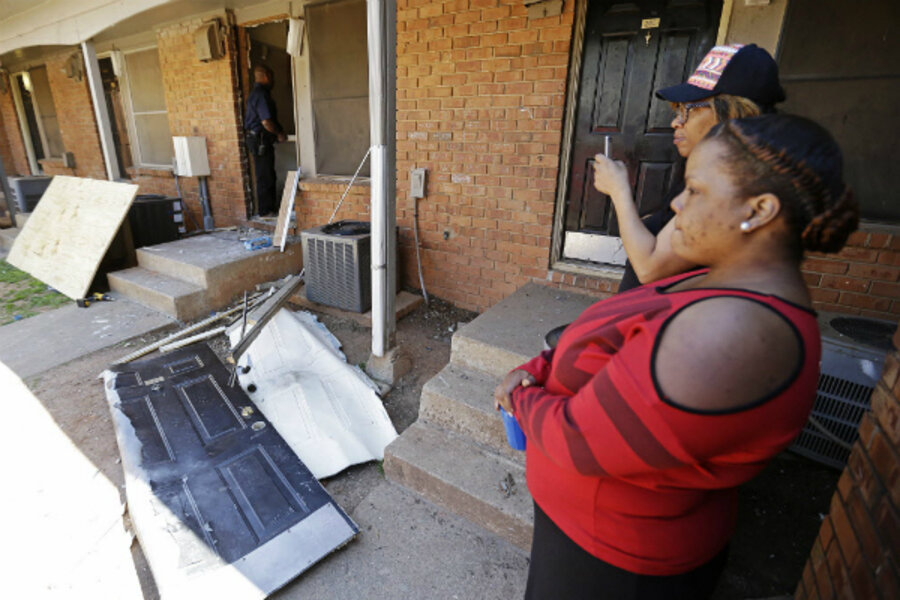N.C. prosecutor kidnap plot: Home attacks on justice officials on the upswing
Part bumbling, part dead serious, the sprawling jailhouse plot to kidnap a North Carolina prosecutor who put a seasoned gang member in prison for life has shaken a US justice system already enduring a slew of deadly attacks.
A federal indictment released Tuesday details a complex plot said to be orchestrated by Kelvin “Dizzy” Melton, a North Carolina prison inmate and alleged higher-up in the Bloods street gang, to pay $10,000 to a group of henchmen on the outside to kidnap and kill his defense attorney and the prosecutor who put him in prison for a 2011 murder.
The plot led the group of nine accomplices first on a goose chase in March from Atlanta to New Orleans, and then to the small town of Wake Forest, N.C., where the group on April 5 grabbed Frank Janssen, the father of Wake County prosecutor Colleen Janssen, after stun-gunning him on the threshold of his home. Ms. Janssen, the actual target, was part of the team that put Mr. Melton away last year.
Mr. Janssen was wrapped in blankets, put on the floor of a rental car, and driven to Atlanta, where he was stashed in an apartment. The kidnapping sparked a four-day manhunt. An FBI unit caught up with the gang after catching a few breaks, including a fast-food receipt left at Janssen’s home by the purported kidnappers.
During the manhunt, kidnappers sent tormenting text messages to Janssen's family, at one point threatening to hurt him and sending a picture of him tied in a chair, according to the indictment. The kidnappers sent a message saying, "Tomorrow we call you again an (sic) if you can not tell me where my things are at tomorrow i will start torchering (sic)," it states. Authorities haven't said what demands the kidnappers made.
Parts of the plot had an amateurish quality, including what ended up being misleading Internet research that put the gang in New Orleans to find a defense attorney who lived in North Carolina. That plot was called off, and US officials say Melton then ordered the team to get Janssen instead.
US law enforcement is framing the plot as a serious situation that could have ended in much greater tragedy. The foiled kidnapping also highlights weaknesses in how the US protects judges and prosecutors, including the vulnerability of their homes and the ability of imprisoned perpetrators to use cellphones to rally associates to do their bidding.
“This deliberate attack on our judicial system cannot be tolerated,” Thomas Walker, US attorney for eastern North Carolina, said in a statement.
The number of attacks on justice employees in the US has jumped to 20 this decade, compared with a total of 86 between 1950 and 2012. The trend was highlighted early last year when two Texas prosecutors and a Colorado prison official were murdered for revenge.
Unlike targeted killings by criminal cartels in Mexico, the attacks on justice officials in the US are harder to explain in terms of motivations, says Glenn McGovern, author of the recent study "Murdered Justice: An Exploratory Study of Targeted Attacks on the Justice Community." According to Mr. McGovern’s research, the motive was revenge in two of three attacks.
“There is not … a predominant criminal background of known offenders,” wrote McGovern, an investigator with the Santa Clara, Calif., Sheriff’s Department, in The Wall Street Journal last year. “The attacks have been committed by murderers, fraudsters, sex offenders, gang members, white supremacists, civil plaintiffs and even professional rivals, such as a rogue cop.”
More immediately, the North Carolina kidnap plot has refocused attention on two system weaknesses. First, Melton was able to use a rogue prison cellphone to communicate with his accomplices on the outside, conducting a conference call at one point to give everyone their assignments, and then even texting them to direct the kidnapping after Mr. Janssen was grabbed, the indictment alleges.
“The case has raised questions about prisoners’ access to mobile phones and launched an investigation into the one that prosecutors contend was used to move people from Georgia to Louisiana and North Carolina and back to Atlanta,” writes Anne Blythe, in the Raleigh News & Observer.
Second, the attack at the home is part of another trend, in which tighter courthouse security has pushed more assailants to attack judges and prosecutors at home. Since 2000, 62 percent of attacks on justice officials occurred at home. Attacks on prosecutors and prison officials last year all happened as the victims opened their front doors to answer a knock.
The challenge for US justice is to be vigilant about threats without adopting a wholesale castle mentality, says McGovern. After all, of 5,250 threats documented between 2003 and 2008, three resulted in attacks against a judge, a prosecutor, or a police officer, according to a 2009 US Justice Department report.
The North Carolina kidnapping allegedly began on April 3, when two women – Dianna Daney Maynard and Patricia Ann Kramer – rented a car in Mableton, Ga. According to the indictment, Melton had offered the women money to round up an Atlanta crew to conduct the kidnappings. The women picked up two men and began their drive to North Carolina. Via text, Melton told them to change into khaki pants and collared shirts, which the crew bought at Wal-Mart. One of the women approached Janssen’s door carrying a clipboard. When he opened it, he was attacked by accomplices, the indictment says.
Police are still searching for Ms. Kramer, who they said funded the kidnapping attempts and did the Google research to try to pinpoint the homes targeted.
Besides Melton and Kramer, police have charged Michael Montreal Gooden, Ms. Maynard, Jakym Camel Quantavious “Kirkwood Quan” Thompson, Clifton James Roberts, Jenna Palin Martin, and Jevante Price with federal kidnapping charges.







